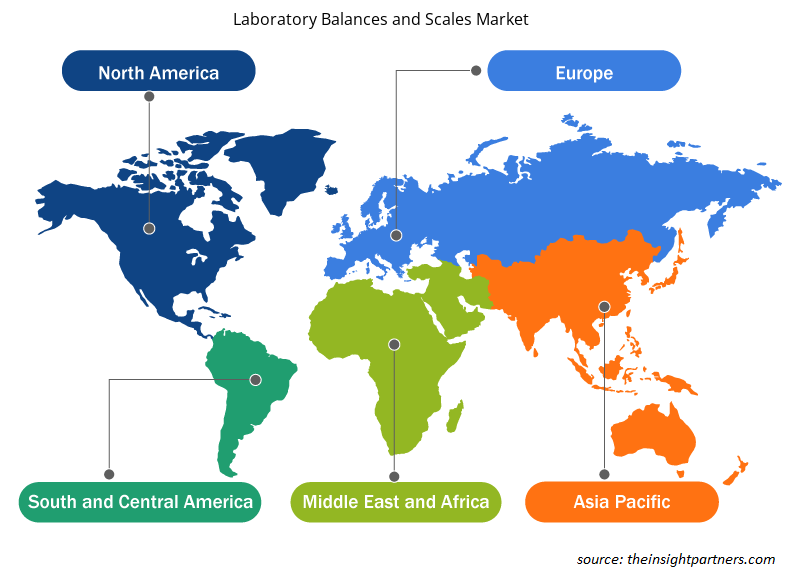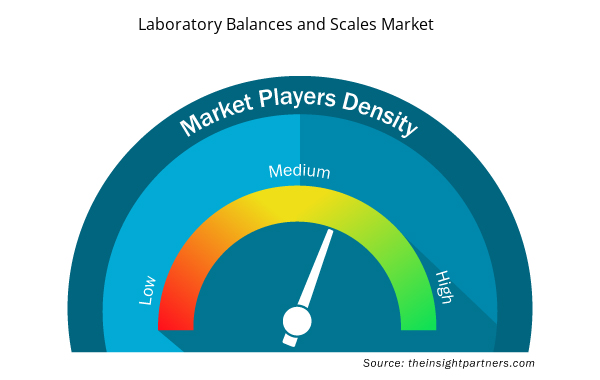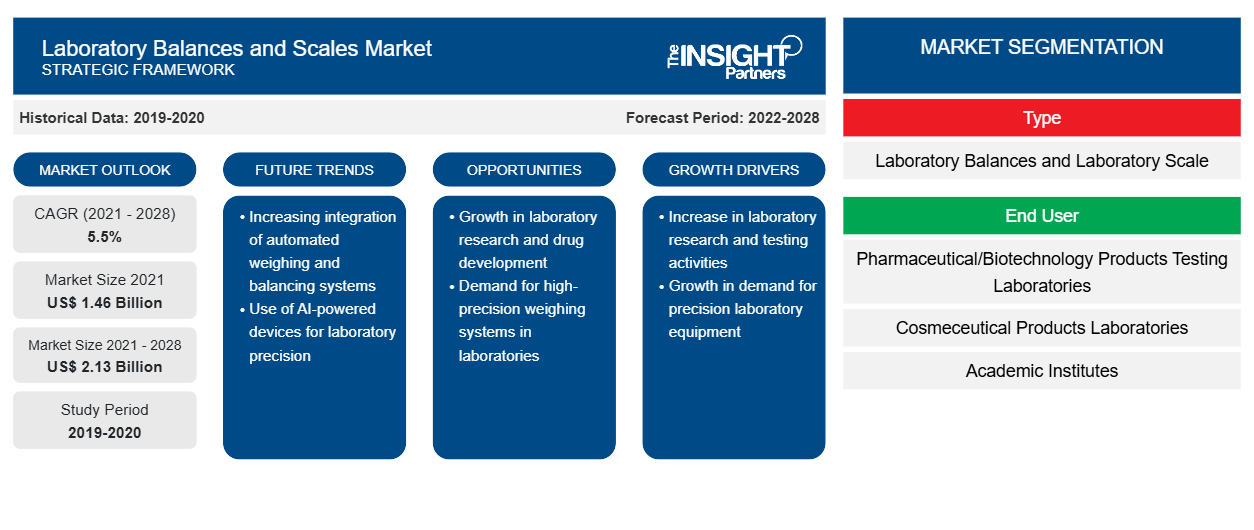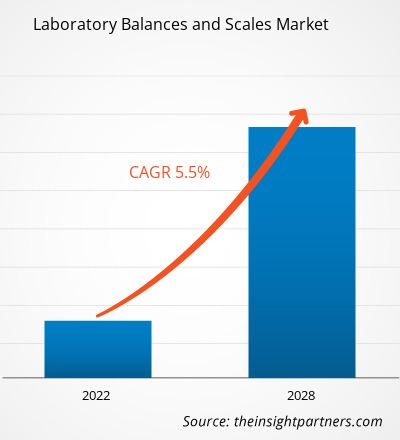Der Markt für Laborwaagen und -waagen soll von 1.463,53 Millionen US-Dollar im Jahr 2021 auf 2.131,14 Millionen US-Dollar im Jahr 2028 anwachsen. Der Markt soll zwischen 2021 und 2028 mit einer durchschnittlichen jährlichen Wachstumsrate (CAGR) von 5,5 % wachsen.
Der Umfang des Marktes für Laborwaagen und -skalen umfasst Typ, Endbenutzer und Region. Der Markt für Laborwaagen und -skalen ist nach Regionen unterteilt in Nordamerika, Europa, Asien-Pazifik, Naher Osten und Afrika sowie Süd- und Mittelamerika. Der Bericht bietet Einblicke und eingehende Analysen des Marktes für Laborwaagen und -skalen und betont dabei verschiedene Parameter wie Markttrends, technologische Fortschritte, Marktdynamik und Wettbewerbslandschaftsanalysen führender Marktteilnehmer auf der ganzen Welt. Es enthält auch eine COVID-19-Auswirkungsanalyse für alle Regionen.
Passen Sie diesen Bericht Ihren Anforderungen an
Sie erhalten kostenlose Anpassungen an jedem Bericht, einschließlich Teilen dieses Berichts oder einer Analyse auf Länderebene, eines Excel-Datenpakets sowie tolle Angebote und Rabatte für Start-ups und Universitäten.
- Holen Sie sich die wichtigsten Markttrends aus diesem Bericht.Dieses KOSTENLOSE Beispiel umfasst eine Datenanalyse von Markttrends bis hin zu Schätzungen und Prognosen.
Markteinblicke
Zunahme der Forschungspipelines von Pharma-Biotech-Unternehmen und Auftragsforschungsinstituten
Die Gesundheitsinfrastruktur erlebt weltweit ein starkes Wachstum bei der Anzahl klinischer Studien und Forschungspipelines. Klinische Studien sind ein entscheidender und wichtiger Schritt, um die Sicherheit und Wirksamkeit einer medizinischen Strategie, Behandlung oder eines Geräts für den kommerziellen Einsatz zu bewerten. Diese Studien helfen auch dabei, die besten medizinischen Ansätze für einen bestimmten Therapiebereich zu verstehen und zu bestimmen. Klinische Studien werden in erster Linie durchgeführt, um Daten zur Sicherheit und Wirksamkeit der Entwicklung neuer Medikamente und Geräte zu sammeln. Vor der Zulassung von Arzneimittelmolekülen oder medizinischen Geräten durch die Aufsichtsbehörden werden eine Reihe klinischer Studien durchgeführt.
Anzahl der registrierten Studien für klinische Studien
Jahr der Erstveröffentlichung | Studien zu Beginn des Jahres | Studien im Jahr | Studien am Ende des Jahres |
2015 | 181.304 | 24.130 | 205.434 |
2016 | 205.434 | 27.809 | 233.243 |
2017 | 233.243 | 29.198 | 262.441 |
2018 | 262.441 | 17.836 | 280.277 |
2019 | 293.275 | 32.519 | 325.794 |
2020 | 325.794 | 36.740 | 362.534 |
Quelle: Clinical Trials.gov und The Insight Partners Analysis
Daher beschleunigt die steigende Zahl klinischer Studien die Nachfrage nach Laborinstrumenten und -geräten, was im Prognosezeitraum letztlich den Markt für Laborwaagen ankurbeln wird.
Typbasierte Erkenntnisse
Der Markt für Laborwaagen und -skalen ist nach Typ in Laborwaagen und Laborwaagen unterteilt. Das Segment Laborwaagen ist weiter unterteilt in Analysewaagen, Toplader-/Präzisionswaagen, Mikro- und Ultramikrowaagen, Feuchtigkeitswaagen, tragbare Waagen und andere Waagen. Das Segment Laborwaagen ist außerdem weiter unterteilt in Tischwaagen, Zählwaagen, Kompaktwaagen und andere Waagen. Das Segment Laborwaagen hatte 2021 den größten Marktanteil, während dasselbe Segment im Prognosezeitraum voraussichtlich die höchste durchschnittliche jährliche Wachstumsrate (CAGR) von 5,8 % auf dem Markt verzeichnen wird.
Regionale Einblicke in den Markt für Laborwaagen und -waagen
Die regionalen Trends und Faktoren, die den Markt für Laborwaagen und -skalen im gesamten Prognosezeitraum beeinflussen, wurden von den Analysten von Insight Partners ausführlich erläutert. In diesem Abschnitt werden auch die Marktsegmente und die Geografie für Laborwaagen und -skalen in Nordamerika, Europa, im asiatisch-pazifischen Raum, im Nahen Osten und Afrika sowie in Süd- und Mittelamerika erörtert.

- Erhalten Sie regionale Daten zum Markt für Laborwaagen und -skalen
Umfang des Marktberichts zu Laborwaagen
| Berichtsattribut | Details |
|---|---|
| Marktgröße im Jahr 2021 | 1,46 Milliarden US-Dollar |
| Marktgröße bis 2028 | 2,13 Milliarden US-Dollar |
| Globale CAGR (2021 - 2028) | 5,5 % |
| Historische Daten | 2019-2020 |
| Prognosezeitraum | 2022–2028 |
| Abgedeckte Segmente | Nach Typ
|
| Abgedeckte Regionen und Länder | Nordamerika
|
| Marktführer und wichtige Unternehmensprofile |
|
Dichte der Marktteilnehmer für Laborwaagen und -skalen: Deren Auswirkungen auf die Geschäftsdynamik verstehen
Der Markt für Laborwaagen und -skalen wächst rasant. Dies wird durch die steigende Nachfrage der Endnutzer aufgrund von Faktoren wie sich entwickelnden Verbraucherpräferenzen, technologischen Fortschritten und einem größeren Bewusstsein für die Vorteile des Produkts vorangetrieben. Mit der steigenden Nachfrage erweitern Unternehmen ihr Angebot, entwickeln Innovationen, um die Bedürfnisse der Verbraucher zu erfüllen, und nutzen neue Trends, was das Marktwachstum weiter ankurbelt.
Die Marktteilnehmerdichte bezieht sich auf die Verteilung der Firmen oder Unternehmen, die in einem bestimmten Markt oder einer bestimmten Branche tätig sind. Sie gibt an, wie viele Wettbewerber (Marktteilnehmer) in einem bestimmten Marktraum im Verhältnis zu seiner Größe oder seinem gesamten Marktwert präsent sind.
Die wichtigsten auf dem Markt für Laborwaagen tätigen Unternehmen sind:
- METTLER TOLEDO
- Sartorius AG
- PCE Instrumente
- OHAUS
- Adam Equipment GmbH
Haftungsausschluss : Die oben aufgeführten Unternehmen sind nicht in einer bestimmten Reihenfolge aufgeführt.

- Überblick über die wichtigsten Akteure auf dem Markt für Laborwaagen und -skalen
Endbenutzerbasierte Erkenntnisse
Laut Angaben werden Laborwaagen und -skalen in Prüflaboren für pharmazeutische und biotechnologische Produkte, in Laboren für kosmetische Produkte, in akademischen Instituten und in Forschungslaboren angeboten. Die Prüflabore für pharmazeutische und biotechnologische Produkte hatten 2020 den größten Marktanteil, und dasselbe Segment wird im Prognosezeitraum voraussichtlich die höchste durchschnittliche jährliche Wachstumsrate (CAGR) von 6,7 % auf dem Markt verzeichnen.
Anorganische Strategien wie Partnerschaften sowie Fusionen und Übernahmen werden häufig von Unternehmen eingesetzt, um der sich ändernden Kundennachfrage gerecht zu werden und ihren Markennamen weltweit zu behaupten. Marktteilnehmer, die auf dem Markt für Laborwaagen und -skalen tätig sind, setzen auch organische Strategien wie Produkteinführung und -erweiterung ein, um ihre Präsenz und ihr Produktportfolio weltweit auszuweiten und die wachsende Nachfrage zu befriedigen.
Nach Typ
- Laborwaagen
- Analysenwaagen
- Toplader-/Präzisionswaagen
- Mikro- und Ultramikrowaagen
- Feuchtigkeitsbilanzen
- Tragbare Waagen
- Andere Guthaben
- Laborwaagen
- Tischwaagen
- Zählwaagen
- Kompaktwaagen
- Andere Skalen
Nach Endbenutzer
- Prüflabore für pharmazeutische und biotechnologische Produkte
- Laboratorien für kosmetische Produkte
- Akademische Institute
- Forschungslabore
Nach Geografie
- Nordamerika
- UNS
- Kanada
- Mexiko
- Europa
- Frankreich
- Deutschland
- Italien
- Vereinigtes Königreich
- Spanien
- Restliches Europa
- Asien-Pazifik (APAC)
- China
- Indien
- Südkorea
- Japan
- Australien
- Restlicher Asien-Pazifik-Raum
- Naher Osten und Afrika (MEA)
- Südafrika
- Saudi-Arabien
- Vereinigte Arabische Emirate
- Rest von MEA
- Süd- und Mittelamerika (SCAM)
- Brasilien
- Argentinien
- Rest von SCAM
Firmenprofile
- METTLER TOLEDO
- Sartorius AG
- PCE Instrumente
- OHAUS
- Adam Equipment GmbH
- GRAMM-PRÄZISION
- RADWAG Waagen
- Scientech Inc.
- BONSO Electronics International Inc.
- A&D Company, Limited
- Historische Analyse (2 Jahre), Basisjahr, Prognose (7 Jahre) mit CAGR
- PEST- und SWOT-Analyse
- Marktgröße Wert/Volumen – Global, Regional, Land
- Branche und Wettbewerbsumfeld
- Excel-Datensatz


- Single-Use Negative Pressure Wound Therapy Devices Market
- Formwork System Market
- Fill Finish Manufacturing Market
- Advanced Planning and Scheduling Software Market
- Electronic Health Record Market
- Thermal Energy Storage Market
- Employment Screening Services Market
- Artificial Turf Market
- Virtual Event Software Market
- Mobile Phone Insurance Market

Report Coverage
Revenue forecast, Company Analysis, Industry landscape, Growth factors, and Trends

Segment Covered
This text is related
to segments covered.

Regional Scope
North America, Europe, Asia Pacific, Middle East & Africa, South & Central America

Country Scope
This text is related
to country scope.
Häufig gestellte Fragen
The costs of the Laboratory Balances and Scales are much higher, and they may cost US$ 300–1500, or more, per type. The cost may also differ from product to product types.
Driving factors include rapid growth of pharmaceutical and biotechnology industry and increasing number of research pipeline of pharma-biotech companies and contract research organizations. However, the limited replacement rate among end users is likely to hamper the growth of the market to a certain extent.
Micro catheter is small-diameter catheter, preferably used during minimally invasive surgeries. . Laboratory balances are specifically used to measure mass of the substance, while laboratory scales are utilized to measure weight of the substances. These scales and balances are classified on the basis of weighing capacity. Weighing of materials play a vital role in research and development as well as production monitoring and quality control.
Trends and growth analysis reports related to Life Sciences : READ MORE..
The List of Companies - Laboratory Balances and Scales Market
- METTLER TOLEDO
- Sartorius AG
- PCE Instruments
- OHAUS
- Adam Equipment Ltd
- GRAM PRECISION
- RADWAG Balances and Scales
- Scientech Inc.
- BONSO Electronics International Inc.
- A&D Company, Limited
The Insight Partners performs research in 4 major stages: Data Collection & Secondary Research, Primary Research, Data Analysis and Data Triangulation & Final Review.
- Data Collection and Secondary Research:
As a market research and consulting firm operating from a decade, we have published and advised several client across the globe. First step for any study will start with an assessment of currently available data and insights from existing reports. Further, historical and current market information is collected from Investor Presentations, Annual Reports, SEC Filings, etc., and other information related to company’s performance and market positioning are gathered from Paid Databases (Factiva, Hoovers, and Reuters) and various other publications available in public domain.
Several associations trade associates, technical forums, institutes, societies and organization are accessed to gain technical as well as market related insights through their publications such as research papers, blogs and press releases related to the studies are referred to get cues about the market. Further, white papers, journals, magazines, and other news articles published in last 3 years are scrutinized and analyzed to understand the current market trends.
- Primary Research:
The primarily interview analysis comprise of data obtained from industry participants interview and answers to survey questions gathered by in-house primary team.
For primary research, interviews are conducted with industry experts/CEOs/Marketing Managers/VPs/Subject Matter Experts from both demand and supply side to get a 360-degree view of the market. The primary team conducts several interviews based on the complexity of the markets to understand the various market trends and dynamics which makes research more credible and precise.
A typical research interview fulfils the following functions:
- Provides first-hand information on the market size, market trends, growth trends, competitive landscape, and outlook
- Validates and strengthens in-house secondary research findings
- Develops the analysis team’s expertise and market understanding
Primary research involves email interactions and telephone interviews for each market, category, segment, and sub-segment across geographies. The participants who typically take part in such a process include, but are not limited to:
- Industry participants: VPs, business development managers, market intelligence managers and national sales managers
- Outside experts: Valuation experts, research analysts and key opinion leaders specializing in the electronics and semiconductor industry.
Below is the breakup of our primary respondents by company, designation, and region:

Once we receive the confirmation from primary research sources or primary respondents, we finalize the base year market estimation and forecast the data as per the macroeconomic and microeconomic factors assessed during data collection.
- Data Analysis:
Once data is validated through both secondary as well as primary respondents, we finalize the market estimations by hypothesis formulation and factor analysis at regional and country level.
- Macro-Economic Factor Analysis:
We analyse macroeconomic indicators such the gross domestic product (GDP), increase in the demand for goods and services across industries, technological advancement, regional economic growth, governmental policies, the influence of COVID-19, PEST analysis, and other aspects. This analysis aids in setting benchmarks for various nations/regions and approximating market splits. Additionally, the general trend of the aforementioned components aid in determining the market's development possibilities.
- Country Level Data:
Various factors that are especially aligned to the country are taken into account to determine the market size for a certain area and country, including the presence of vendors, such as headquarters and offices, the country's GDP, demand patterns, and industry growth. To comprehend the market dynamics for the nation, a number of growth variables, inhibitors, application areas, and current market trends are researched. The aforementioned elements aid in determining the country's overall market's growth potential.
- Company Profile:
The “Table of Contents” is formulated by listing and analyzing more than 25 - 30 companies operating in the market ecosystem across geographies. However, we profile only 10 companies as a standard practice in our syndicate reports. These 10 companies comprise leading, emerging, and regional players. Nonetheless, our analysis is not restricted to the 10 listed companies, we also analyze other companies present in the market to develop a holistic view and understand the prevailing trends. The “Company Profiles” section in the report covers key facts, business description, products & services, financial information, SWOT analysis, and key developments. The financial information presented is extracted from the annual reports and official documents of the publicly listed companies. Upon collecting the information for the sections of respective companies, we verify them via various primary sources and then compile the data in respective company profiles. The company level information helps us in deriving the base number as well as in forecasting the market size.
- Developing Base Number:
Aggregation of sales statistics (2020-2022) and macro-economic factor, and other secondary and primary research insights are utilized to arrive at base number and related market shares for 2022. The data gaps are identified in this step and relevant market data is analyzed, collected from paid primary interviews or databases. On finalizing the base year market size, forecasts are developed on the basis of macro-economic, industry and market growth factors and company level analysis.
- Data Triangulation and Final Review:
The market findings and base year market size calculations are validated from supply as well as demand side. Demand side validations are based on macro-economic factor analysis and benchmarks for respective regions and countries. In case of supply side validations, revenues of major companies are estimated (in case not available) based on industry benchmark, approximate number of employees, product portfolio, and primary interviews revenues are gathered. Further revenue from target product/service segment is assessed to avoid overshooting of market statistics. In case of heavy deviations between supply and demand side values, all thes steps are repeated to achieve synchronization.
We follow an iterative model, wherein we share our research findings with Subject Matter Experts (SME’s) and Key Opinion Leaders (KOLs) until consensus view of the market is not formulated – this model negates any drastic deviation in the opinions of experts. Only validated and universally acceptable research findings are quoted in our reports.
We have important check points that we use to validate our research findings – which we call – data triangulation, where we validate the information, we generate from secondary sources with primary interviews and then we re-validate with our internal data bases and Subject matter experts. This comprehensive model enables us to deliver high quality, reliable data in shortest possible time.


 Holen Sie sich ein kostenloses Muster für diesen Bericht
Holen Sie sich ein kostenloses Muster für diesen Bericht